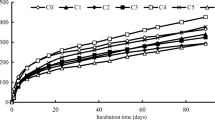Abstract
If heterocontinuous flow-cultivation method was used to study the degradation of soluble carboxymethyl cellulose (CMC) in soil, neither the potential CM-cellulase activity of the soil nor the total degree of CMC mineralization significantly differed under aerobic condition and in a nitrogen atmosphere. In contrast, the end products of the enzymatic hydrolysis and their mutual proportions were different: under anaerobic conditions, the formation of reducing sugars was increased at the expense of CO2 production and organic acids were detectable in the extract. The composition of soil microflora also differed. Addition of ammonium ions affected the maximum CM-cellulase activity in the soil, the degree of substrate mineralization, the proportion of CO2 and reducing sugars that are formed and the concentration of the present soil microflora.
Similar content being viewed by others
References
Bryant F., Overkll B.T.: Quantitative chromayography analysis of organic acids in plant tissue.Biochim. Biophys. Acta 10 471–481 (1953).
Hanzlíková A., Jandera A., Kune F.: Formation of poly-3-hydroky butyrabe by a soil microbial community during batch and hoberocontinuous contivation.Folia Microbiol. 29 233–241 (1984).
Khan A. W., Wall D., van der Beeg L.: Fermentative conversion of cellulose to acetic acid and cellulolytic enzyme production by a bacterial mixed culture obtained from sewage sludge.Appl. Environ. Microbiol. 41, 1214–1218 (1981).
Macura J.: Continuous flow method in soil microbiology: I. Apparatus.Folia Microbiol. 6, 328–338 (1961).
Macura J.: Heterocontinuous cultivation of soil microorganisms. (In Czech)DSc Thesis. Institute of Microbiology, CzechAcad. Sci., Prague 1969.
Mašková H., Jandera A.: Study of the formation and properties of soil cellulolytic enzyme complex during batch cultivation.Folia Microbiol. 34, in press (1989).
Mašková H.P., Vasilyeva L.V., Kunc F., Kofroňová O.: Studies of the microflora participating in the decomposition of CMC continuously added to soil.Folia Microbiol. 33, 482–490 (1988).
Nikitin D.I., Nikitina E.S.:Processes of Self-Cleaning of the Environment and Parasites of Bacteria. (In Russian) Nauka, Moscow 1978.
Spiro R.G.: Analysis of sugars found in glucoproteins.Methods Enzymol. 8, 3–26 (1966).
Takai Y., Macura J., Kunc F.: Anaerobic decomposition of glucose continuously added to soil.Folia Microbiol. 14, 327–333 (1969).
Author information
Authors and Affiliations
Additional information
The authors thank Dr. M. Balíkevá from theInstitute of Toxicology and Forensic Chemistry of the Faculty of Medicine, Charles University, Prague, for help with the analysis of organic acids.
Rights and permissions
About this article
Cite this article
Mašková, H.P., Kunc, F. Microbial decomposition of carboxymethyl cellulose continuously added to the soil. Folia Microbiol 33, 474–481 (1988). https://doi.org/10.1007/BF02925774
Received:
Issue Date:
DOI: https://doi.org/10.1007/BF02925774




